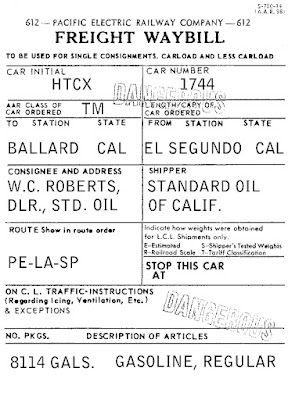I continue to try and incorporate as many prototype details into my model waybills as is practical. Thus among the most interesting examples of prototype waybills are the ones with complications. I describe such an example below, along with what one can perhaps learn from it. And once again, I thank Andy Laurent, for not only supplying this waybill image, but for his diligence in maintaining a large bill collection.
The bill I discuss here is an LS&I waybill for rough lumber. The car carrying the load is MILW 66335, a 52-ft., 6-in. 50-ton flat car, flat cars being the usual choice for rough lumber. What’s interesting about this bill is the re-consignment aspect. The waybill is included in its entirety below. You can enlarge it if you wish, by clicking on it.
One’s eye is immediately drawn to the “X-ed out” parts in the consignee column at left, accomplished by typewriter. Replacement destination information is typed in, in a slightly different-looking face and different size and darkness of letters. This is an appearance we might wish to capture in model waybills of this kind. Note that the re-consignment was made by the LS&I agent at Marquette, presumably before or just as the load was departing.
The load departed Marquette, Michigan, in the Upper Peninsula, and was originally destined to Black Creek, Wisconsin, both from and to Lake Superior Lumber Co. But note in the original consignee description, the line “FOR RECONSIGNMENT.” This load was intended from the beginning to be reconsigned. The new consignee was Algoma Plywood, on the Ahnapee & Western.
The load traveled only 32 miles on the LS&I before interchanging to the Soo Line at Eben, Michigan, as originally intended. It then moved on the Soo to Black Creek, Wisconsin, 24 miles west of Green Bay, where it was interchanged to the Green Bay & Western, thence via KGB&W and A&W to Algoma.
Note also the weighing information in the right-hand column. The car was weighed at West Yard in Marquette on the LS&I. Stamped on the waybill is the scale verification from the Western Weighing and Inspection Bureau for this scale, although the actual weights are typed in on the form, not written in the stamp spaces.
Further, note in the cargo section, that the “number of packages” column at left shows “C/L,” meaning “carload,” a very common notation on waybills, since nearly all freight was billed by weight.
It may also be interesting to note the interchange stamps at bottom. At left is the Soo Line stamp from Black Creek, Wisconsin, where the load moved to the GB&W. It’s dated August 21, five days after the original waybill date of August 16. But it took six more days to be stamped on the A&W at Sturgeon Bay. Sturgeon Bay is 19 miles beyond Algoma, presumably reflecting the car arriving in a train directly from the KGB&W interchange, and then destined to move in a local freight, in the reverse direction to Algoma.
On a related topic, in previous posts, I have mentioned a number of things about the rubber stamp images one sees on most waybills. One example of an interesting variation is the “open” lettering used for
a “dangerous” stamp in one bill I have seen. It was shown among a
discussion of tank car waybills (see it at: https://modelingthesp.blogspot.com/2023/03/waybills-part-107-tank-cars.html ), and just the part with the stamp is repeated below.
This makes a change from the “solid” lettering of danger stamps shown earlier. One can also rotate the stamp so that it looks quickly applied, as in this model example:
These additional details of waybill content continue to interest me, and I continue to add them to my model waybills as appropriate. It’s my goal to make my layout operating sessions increasingly realistic through improved paperwork.
Tony Thompson



No comments:
Post a Comment